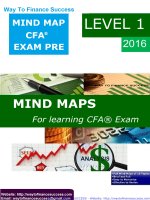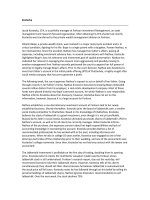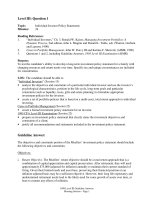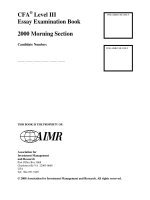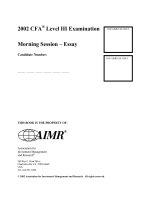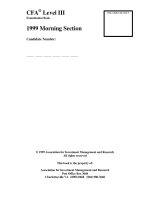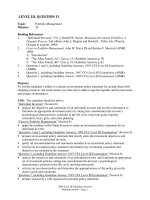CMT level 1 sample exam b 2016
Bạn đang xem bản rút gọn của tài liệu. Xem và tải ngay bản đầy đủ của tài liệu tại đây (1.76 MB, 43 trang )
SAMPLE
CMT LEVEL I EXAM
PREFACE:
The following document is a sample exam only, not an actual exam of current or former
designation in any way. The questions have been constructed/ phrased in a manner that is
similar to past exams, but none of these questions, to the knowledge of the MTA staff,
have ever appeared on an exam. The objective of this sample exam is to give as clear an
indication as possible of the question structure and language one can expect in the exam.
Every reasonable effort has been taken to make these exam questions representative of
what candidates will see in the exams, however the following caveats should be noted.
Exam questions change constantly. There may be up to 25% variation in the question
mix in the Level I exams from one test cycle to the next. These sample questions are
patterned after a limited number of questions drawn from a much larger pool of actual
exam questions. This further increases the chances that the questions appearing in the
exam may be significantly different from those contained in this sample. Candidates are
cautioned not to expect the questions from the previous years’ exams to appear in the
current year.
Candidate knowledge and experience will vary. The actual exam questions may be more
difficult than those represented here, though that is unintentional. A question may be
more difficult for one candidate and not another.
The sample questions cover a variety of topics; however, in the actual exam the
weighting may vary, i.e. the proportion of questions drawn from different topics may be
different from the pattern followed in this sample paper.
The actual exam consists of 135 questions of which 120 are scored items. Candidates
are allotted two and half hours to take the Level I exam. This sample exam should be
completed in 2.5 hours to better simulate performance on the exam.
Please note that this sample question booklet has been prepared completely
independently from the exam to ensure that the questions that will appear in the actual
exam paper remain secure and confidential. Candidates are encouraged to utilize this
resource and to discuss and clarify questions regarding the areas of the Body of Knowledge
where they lack familiarity or seek better understanding.
This book of practice exams is produced by Market Technicians Association, Inc., 61 Broadway, Suite 514
New York, NY 10006
CMT Level 1 Sample Questions – Candidate Answer Sheet
1.________
31.________
61.________
91.________
121.________
2.________
32.________
62.________
92.________
122.________
3.________
33.________
63.________
93.________
123.________
4.________
34.________
64.________
94.________
124.________
5.________
35.________
65.________
95.________
125.________
6.________
36.________
66.________
96.________
126.________
7.________
37.________
67.________
97.________
127.________
8.________
38.________
68.________
98.________
128.________
9.________
39.________
69.________
99.________
129.________
10.________
40.________
70.________
100.________
130.________
11.________
41.________
71.________
101.________
131.________
12.________
42.________
72.________
102.________
132.________
13.________
43.________
73.________
103.________
133.________
14.________
44.________
74.________
104.________
134.________
15.________
45.________
75.________
105.________
135.________
16.________
46.________
76.________
106.________
136.________
17.________
47.________
77.________
107.________
137.________
18.________
48.________
78.________
108.________
138.________
19.________
49.________
79.________
109.________
139.________
20.________
50.________
80.________
110.________
140.________
21.________
51.________
81.________
111.________
141.________
22.________
52.________
82.________
112.________
142.________
23.________
53.________
83.________
113.________
143.________
24.________
54.________
84.________
114.________
144.________
25.________
55.________
85.________
115.________
145.________
26.________
56.________
86.________
116.________
146.________
27.________
57.________
87.________
117.________
147.________
28.________
58.________
88.________
118.________
148.________
29.________
59.________
89.________
119.________
149.________
30.________
60.________
90.________
120.________
150.________
1. Annie Jones is the portfolio manager for a large-cap equity investment fund. Her
colleagues at another investment fund share details about a small-cap company that is
now showing a long-term basing pattern on the price charts, and whose prospects for
future growth and earnings are outstanding. She invests in the company on behalf of the
fund, and over the course of the next three years, the performance of the company’s stock
contributes greatly to her investment fund beating its benchmark. Jones:
A. has violated the CFA Institute Code and Standards because her investment in the small-cap
company is contrary to the stated objectives of the fund.
B. has not violated the CFA Institute Code and Standards because she conducted additional
research based on the information and found supporting evidence of her trade action.
C. has violated the CFA Institute Code and Standards because she was made aware of the
opportunity by her colleagues at another firm, thereby using confidential information in the
process.
D. has not violated the CFA Institute Code and Standards because the investment was in the
common stock of a listed entity, which is allowed by the investment fund she manages.
2. Which of the following actions is most likely to comply with the CFA Institute Code and
Standards?
A. Posting information about questions from a prior year’s exam on a public discussion forum
B. Join discussion groups on LinkedIn/Facebook to discuss and share exam questions
C. Posting derogatory comments regarding the CMT® Program on a website for CMT
candidates
D. Providing your exam prep course provider with a list of topics not tested from the body of
knowledge
3. Maggie manages several client portfolios. She utilizes the research of highly skilled
analysts in her firm to support her investment decisions. Maggie:
A. complied with the CFA Institute Code and Standards.
B. violated the CFA Institute Code and Standards because she failed to disclose this
information to her clients.
C. violated the CFA Institute Code and Standards because she did not exercise due
diligence in making her investment decisions.
D. violated the CFA Institute Code and Standards because she was unfamiliar with the
processes and procedures used by the analysts to arrive at recommendations.
4. Which of the following is most likely to be considered a “material” piece of information
regarding a company?
a) A former board member predicting a long-term decline in the company’s stock
b) The loss of a customer representing a significant portion of a company’s gross sales
c) The loss of a customer representing a negligible portion of a company’s gross sales
d) A competitor CEO’s speculation of a pending management change at the company
5. Qi Lee received a year-end gift of an expensive Rolex watch from a client who was
delighted by the performance of his portfolio, which was managed by Lee. Lee should:
a) decline the gift, as it is prohibited under the CFAI Code of Ethics and Standards.
b) decline the gift, as it may have an unintended impact on future performance.
c) accept the gift, keeping the matter confidential.
d) accept the gift, and disclose it to his employer.
6.
a)
b)
c)
d)
When the New High-New Low Index is above its centerline, it shows that:
it is better to step aside and wait for another trade.
the Market may consolidate near-term, but eventually rise.
market leaders are bullish and it is better to trade from the long side.
market leaders are bullish, but it is time to take profits on long positions.
7. If the New High-New Low Index declines while the broad market stays flat or rallies, it is
time to:
a) initiate fresh longs.
b) initiate fresh shorts.
c) take profits on short positions.
d) take profits on long positions.
8. The Advance/Decline line is calculated by:
a) subtracting the number of declining stocks from advancing stocks and ignoring unchanged
stocks.
b) subtracting the number of advancing stocks from declining stocks and ignoring unchanged
stocks.
c) subtracting the number of advancing stocks and unchanged stocks from declining stocks.
d) subtracting the number of advancing stocks from declining stocks and adding back the
unchanged stocks.
9.
a)
b)
c)
d)
If the stock market reaches a new peak while the A/D line does not, it indicates that:
the market may still continue to move higher.
many stocks are participating and the rally may still continue.
many stocks are participating and the rally may be near its end.
fewer stocks are participating and the rally may be near its end.
10. When analyzing candlestick price charts, the appearance of a long body in the same
direction as the existing trend indicates:
a) a potential reversal.
b) rising momentum.
c) continuation.
d) consolidation.
11. Identify the candlestick pattern in which the opening and closing prices are very close or
same.
a) Doji
b) Marubozu
c) Piercing line
d) Dark cloud cover
12. When a series of short candlesticks appears after a period of relatively long sessions, it
implies a:
a) reversal.
b) sell signal.
c) rising momentum.
d) weakening momentum.
13. A candlestick that has a long upper shadow, emerging after an extended uptrend, suggests
that:
a) sellers have lost momentum.
b) buyers have lost momentum.
c) both buyers and sellers have lose momentum.
d) lack of decisive control by either buyers or sellers.
14. Momentum measures:
a) the rate of change in price.
b) the change in price.
c) investor psychology.
d) investor Sentiment.
15. Lower-priced securities tend to have _______ ATR (Average True Range) and higherpriced securities tend to have _______ ATR.
a) higher, higher
b) lower, higher
c) higher, lower
d) lower, lower
16. Average True Range (ATR) is an indicator that measures:
a) volume.
b) breadth.
c) volatility.
d) momentum.
17. A breakaway gap usually:
a) provides a major divergence signal.
b) signals the beginning of a new trend.
c) occurs at the end of an important price move.
d) occurs during the accumulation phase of the market cycle.
18. Common gaps usually appear in a:
a) trading range.
b) bullish market.
c) bearish market.
d) trending market.
19. During a consolidation phase, price action normally:
a) attempts a breakout within three weeks.
b) attempts a breakout within three months.
c) moves within well-defined neutral boundaries on low volume.
d) moves within well-defined neutral boundaries on high volume.
20. An exponential moving average:
a) gives more weight to the most recent observation.
b) gives less weight to the most recent observation.
c) gives equal weight to all observations.
d) does not suffer from any lag.
21. Gaps normally occur:
a) between the close of the market on one day and the open of the next day.
b) between the close of the market on one day and the close of the next day.
c) between the open of the market on one day and the open of the next day.
d) between the high of the market on one day and the open of the next day.
22. Which of the following measures makes use of price and volume in its calculation?
a) Plurality Index
b) The Arms Index
c) Relative Strength Index (RSI)
d) The Money Flow Index (MFI)
23. Which of the following types of moving averages drops off an old data point when a new
one is added?
a) Simple Moving Average
b) Weighted Moving Average
c) Triangular Moving Average
d) Exponential Moving Average
24. MACD line is calculated by:
a) subtracting the 26-day simple moving average from the 12-day simple moving average.
b) subtracting the 12-day simple moving average from the 26-day simple moving average.
c) subtracting the 26-day exponential moving average from the 12-day exponential moving
average.
d) subtracting the 12-day exponential moving average from the 26-day exponential moving
average.
25. The basis of OBV is the belief that:
a) price precedes volume.
b) volume precedes price.
c) volume matters most during breakouts.
d) volume and price are typically coincident indicators.
26. Top-down analysis refers to an analysis of:
a) d monetary policy.
b) company fundamentals.
c) the overall economic and business condition.
d) a specific government, company, (or) asset.
27. Government and companies raise money from investors in:
a) money markets.
b) primary markets.
c) secondary markets.
d) both primary and secondary markets.
28. Calculate the nominal return based on the information provided below:
The S&P 500 index fell 0.003 percent in 2015.
Dividends paid during the year equaled 2.089 percent of the index’s value.
Inflation was 3.4 percent, based on the change in the Consumer Price Index (CPI)
for the 10 months ended in November.
a) -2.08%
b) -1.3%
c) 1.30%
d) 2.08%
29. __________ affects the amount of funds available to the economy as well as their cost.
a) Credit policy
b) Economic policy
c) Monetary policy
d) Investment policy
30. Yield refers to the projected annual return on a bond based on:
a) The interest rate of the bond.
b) the current price of the bond.
c) future interest payments.
d) A and B.
31. When a bond’s price is greater than 100, the yield is:
a) lower than the prime rate.
b) lower than the coupon rate.
c) higher than the coupon rate.
d) lower than the discount rate.
32. Treasury inflation-protected securities (TIPS) are bonds whose _______ is adjusted as the
consumer price index fluctuates:
a) principal
b) interest rate
c) future value
d) discount rate
33. An inverted yield curve has historically pointed toward:
a) economic expansions.
b) inflationary pressures.
c) deflationary pressures.
d) slower economic growth and recessions.
34. Treasury bill returns come from:
a) volatility.
b) price changes.
c) interest payments.
d) dividend payments
35. The treasury yield curve is usually:
a) flat.
b) humped.
c) inverted.
d) upward sloping.
36. _______ are bonds without any collateral backing them other than a company’s full faith
and credit.
a) Debentures
b) Treasury bill
c) Commercial paper (CP)
d) Certificates of deposit (CDs)
37. _______ give companies the option to buy them back before maturity.
a) Treasury bills
b) Putable bonds
c) Callable bonds
d) Convertible bonds
38. _______ provide investors with the option to swap debt for equity.
a) Treasury bills
b) Putable bonds
c) Callable bonds
d) Convertible bonds
39. At least _______ touches of each trend line are required for a valid rectangle.
a) one
b) two
c) three
d) four
40. A symmetrical triangle should be longer than:
a) one week.
b) two weeks.
c) three weeks.
d) three months.
41. _______ occurs after an upward breakout when prices return to the breakout point or
chart pattern boundary within 30 days.
a) A pullback
b) A relief rally
c) A throwback
d) A dead cat bounce
42. When analyzing long term price movements, it could be helpful to use a _______ chart.
a) Logarithmic
b) Candlestick
c) EquiVolume
d) Pont and Figure
43. An uptrend line has:
a) a positive slope and is formed by connecting two or more low points.
b) a positive slope and is formed by connecting two or more high points.
c) a negative slope and is formed by connecting two or more high points.
d) a negative slope and is formed by connecting two or more low points.
44. The key variable in the CAPM (Capital Asset Pricing Model) equation is:
a) Rho.
b) Beta.
c) Delta.
d) Alpha.
45. A complete Elliott wave cycle is made up of _______ waves.
a) three
b) five
c) eight
d) thirteen
46. In Elliott wave theory, sub-waves 2 and 4 are called:
a) Zigzags.
b) Motive waves.
c) Impulse waves.
d) Corrective waves
47. _______ is a sideways, three-wave corrective pattern.
a) Flat
b) Zigzag
c) Triangle
d) Ending Diagonal
48. Open interest in a futures contract represents:
a) the number of contracts traded in a day.
b) the sum of total volume and open interest.
c) the number of outstanding contracts on any given day.
d) the number of outstanding contracts in first day of the month.
49. Which of the following is a CORRECT interpretation of open interest?
a) Rising open interest in an uptrend is bearish.
b) Rising open interest in a downtrend is bullish.
c) Declining open interest in an uptrend is bearish.
d) Declining open interest in a downtrend is bearish.
50. Force Index is calculated by:
a) subtracting the previous day’s close from the current day’s close and multiplying by
volume.
b) subtracting the current day’s close from the previous day’s close and multiplying by
volume.
c) subtracting the previous day’s close from the current day’s close and multiplying by the
10-day average volume.
d) subtracting the previous day’s close from the current day’s close and multiplying by the
10-day average volume.
51. A protective stop is:
a) an order to sell below the market when you are long.
b) a stop-loss order that protects you from getting badly hurt by a reversal.
c) an order to cover the short positions above the market when you are short.
d) All of the above
52. In constructing a Point & Figure chart, a new box is added only when:
a) price has moved to a new high.
b) volume confirms the price movement.
c) price has moved by less than the specified box size.
d) price has moved by equal to or more than the specified box size.
53. Violated support levels typically:
a) lose importance after three weeks.
b) indicate an imminent price reversal.
c) lose importance after three months.
d) become overhead resistance on price bounces.
54. A rising relative strength line for a stock in a falling market indicates that:
a) price and volume are diverging.
b) the stock is performing worse than the market.
c) the stock is performing better than the market (on a relative basis).
d) the stock is performing better than the market (on an absolute basis).
55. Which of the following lists arranges cycles from shortest to longest in duration?
a) Presidential, seasonal, Kondratieff
b) Kondratieff, Presidential, seasonal
c) Seasonal, Presidential, Kondratieff
d) Presidential, Kondratieff, seasonal
56. A narrowing of Bollinger Bands normally indicates that:
a) a stock is ready for a rally.
b) a stock is ready for a decline.
c) a stock’s volatility has increased.
d) a stock’s volatility has decreased.
57. A company whose stock is in a well-established uptrend, reports earnings slightly above
consensus estimates. After an initial rally, the stock then ends lower on the day. This
would probably be an example of:
a) market discounting.
b) investor under reaction.
c) unrealistic expectations.
d) a short-coming of fundamental analysis.
58. To increase the sensitivity of a 5×3 Point & Figure chart, one would:
a) increase the box size.
b) decrease the box size.
c) increase the number of boxes needed for a reversal.
d) opt for a one-box reversal type Point & Figure chart.
59. You are updating a one box reversal Point & Figure chart. The box size is $1 and the
current column has 4 X’s. The most recent posting is $40. The stock closed yesterday at
$40.50. Today, the stock opened at $40.60, ran up to $40.95, and closed at the low for the
day at $39.11. How many new postings will you be making on the chart to reflect today’s
trading?
a) 0
b) 1
c) 2
d) 3
60. Cycles are usually measured from:
a) curl to curl.
b) high to high.
c) crest to crest.
d) trough to trough.
61. In a 5-day simple moving average, each day’s price is assigned a weighting of:
a) 5%.
b) 10%.
c) 20%.
d) 25%.
62. Volume divergences occur when:
a) volume expands while open interest contracts.
b) volume declines during a sideways congestion pattern.
c) volume expands while the daily trading range contracts.
d) a new high in an uptrend takes place on declining volume.
63. The primary use of a candlestick pattern is to:
a) determine if you are in a bull market or a bear market.
b) define the primary, intermediate, and short-term trends.
c) strengthen the possibility of a reversal or continuation of a price trend.
d) define the intermediate and short-term trends, but not the primary trend.
64. Which is an example of candle pattern filtering?
a) Using cycles to confirm the existence of a pattern
b) Using western techniques to confirm a candle pattern
c) Accepting only those patterns that fit the strict definition of their pattern
d) Accepting only those patterns that are confirmed by the intermediate-term trend
65. A Point & Figure chart:
a) ignores time.
b) is limited by a four-year time horizon.
c) cannot be used to project price targets.
d) gives a clear picture of volume distribution.
66. The Kondratieff cycle extends for a period of about:
a) 13 years.
b) 50 years.
c) 54 years.
d) 60 years
67. A weak economy is usually favorable for which of the following asset classes?
a) Bonds
b) Stocks
c) Real estate
d) Commodities
68. Trend lines:
a) are not useful for short-term trading.
b) offer late confirmation of a change in trend.
c) are more significant the longer they stay in force.
d) can only be determined by least square regression method.
69. Which of the following is a consolidation pattern?
a) Flag
b) Diagonal
c) Rising wedge
d) Broadening formation
70. Seasonality is a cycle that occurs:
a) yearly.
b) weekly.
c) monthly.
d) quarterly.
71. The interchangeability of a financial instrument is normally referred to as:
a) hedging.
b) fungibility.
c) arbitraging.
d) backwardation.
72. The VIX index measures:
a) the implied volatility of the S&P 100 index options.
b) the historical volatility of the S&P 500 index options.
c) the historical volatility of the S&P 100 index options.
d) the implied volatility of the S&P 500 index options.
73. If the VIX is quoted at 20, it indicates the market is expecting a movement of about
_______ percent over the next 30 days.
a) 3.77
b) 5.77
c) 3.33
d) 5.07
74. In a double bottom pattern, volume is generally:
a) rising throughout the pattern.
b) declining throughout the pattern.
c) lower on the left bottom than the right.
d) higher on the left bottom than the right.
75. When an economic crisis begins, investors generally buy ______ securities for their
relative safety and sell _______ securities.
a) corporate, treasury
b) treasury, corporate
c) commercial papers, corporate
d) corporate, TIPS (Treasury Inflation-Protected Securities)
76. The _______ index is a popular benchmark for measuring the performance of small-cap
companies.
a) S&P 500
b) Russell 2000
c) NASDAQ Composite
d) Dow Jones Industrial Average
77. The NASDAQ Composite index is a _______ weighted index.
a) market-cap
b) price
c) trade
d) equal
78. The quadratic mean is often used for an estimation of:
a) error.
b) return.
c) growth.
d) volatility.
79. The harmonic mean is a _______ weighted average.
a) price
b) time
c) trade
d) volume
80. Bullish support lines on a 3-box reversal Point & Figure chart are drawn at a ______
degree angle:
a) 45
b) 60
c) 75
d) 90
81. If the fund has a beta of 1.2, then it has _______ than the overall market.
a) 2% more volatility
b) 20% less volatility
c) 0.2% more volatility
d) 20% more volatility
82. An effective way of detrending price data to identify cycles is to:
a) use an oscillator and identify extreme levels.
b) use a moving average of the highs/lows over n periods.
c) divide the closing prices by a moving average of those prices.
d) plot a linear regression (best-fit) line through the data midpoint.
83. An important feature of the Martingale process that makes it an appropriate model for
EMH is:
a) the absence of future price predictability.
b) the absence of price return anomalies that are unexplained.
c) the presence of price return anomalies that are unexplained.
d) the presence of information that aids in future price predictability.
84. In EMH, technical traders can be thought of as a specific type of noise trader because:
a) technical traders are rational traders.
b) technical traders are not rational traders.
c) a positive feedback loop can lead to pronounced bubbles.
d) the cancel-out phenomenon will apply to a large number of trend following strategies.
85. The stochastics indicator measures:
a) where today’s typical price fits into the recent trading range.
b) the distance in percentage between the first and last values over n-days.
c) the relative position of the closing price within a past high-low range.
d) the relative strength of the current price movement as it increases from 0 to 100.
86. Which of the following statements is an important assumption of the Efficient Market
Hypothesis?
a) Investors as a group will act irrationally.
b) Investors as a group will act rationally.
c) Prices typically do not reflect all available information.
d) Liquidity constraints may sometimes drive prices away from their intrinsic value.
87. Slippage is normally attributed to:
a) liquidity risk.
b) default risk.
c) market risk.
d) credit risk.
88. Objective technical analysis methods:
a) normally witness less drawdown.
b) normally witness high drawdown.
c) require a disciplined approach for success.
d) are well-defined procedures that issue unambiguous signals.
89. When a great majority of investors have the same view of the market:
a) market sentiment is positive.
b) it is safe to assume that the market may trend to further highs.
c) it is a warning to expect a reversal contrary to the majority opinion.
d) it is safe to assume that a reversal of trend is a low-probability outcome.
90. The Fed largely controls:
a) money supply.
b) long-term interest rates.
c) short-term interest rates.
d) both money supply and long-term interest rates.
91. Which of the following scenarios is generally followed by weakness in equity markets?
a) Higher interest rates
b) Lower interest rates
c) Slower money-supply growth
d) Both higher interest rates and slower money-supply growth
92. Monetary indicators are considered _______ indicators.
a) internal
b) external
c) sentiment
d) momentum
93. The concept of randomness in price action is directly related to the:
a) Dow Theory
b) Elliott wave theory
c) Pythagorean theorem
d) evolution of the probability theory
94. As per the theory of contrary opinion, a high degree of consensus normally precedes a:
a) trend reversal
b) trend continuation
c) short-term consolidation
d) pause within an existing trend
95. The white or black portion of a candlestick is also referred to as a/the:
a) Doji
b) Shadow
c) Real body
d) Spinning top
96. _______ has the highest component weighting in the U.S. Dollar index.
a) Euro
b) Japanese Yen
c) British pound
d) Canadian dollar
97. The square root of variance is also referred to as:
a) Mean deviation.
b) Quadratic mean.
c) Harmonic mean.
d) Standard deviation.
98. When a larger number of stocks register new lows vs. new highs, the New High-New
Low Index is:
a) Positive, and is below the centerline.
b) Positive, and is above the centerline.
c) Negative, and is above the centerline.
d) Negative, and is below the centerline.
99. The “Percentage of stocks above their 50-day MA” indicator is considered to be
overbought, when it crosses above:
a) 50%.
b) 80%.
c) 75%.
d) 60%.
100.
a)
b)
c)
d)
Identify the Point & Figure pattern highlighted below:
Quadruple Top Buy
Upside Breakout of a Descending Triangle
Upside Breakout of a Symmetrical Triangle
Upside Breakout of an Ascending Triangle
101.
a)
b)
c)
d)
Triangle
Rising wedge
Ending Diagonal
Leading Diagonal
102.
a)
b)
c)
d)
The Elliott Wave pattern highlighted below is a/an:
Identify the Elliott Wave pattern highlighted below:
Flat in a bull market
Flat in a bear market
Zigzag in a bull market
Zigzag in a bear market
103.
a)
b)
c)
d)
Flat
Regular Flat
Running Flat
Expanded Flat
104.
a)
b)
c)
d)
The Elliott Wave pattern highlighted below is a/an:
Identify the Elliott Wave pattern highlighted below:
Expanded Flat
Running Flat
Regular Flat
Zigzag
105. Identify the following “Double-Three” combination pattern as per the Elliott Wave
Theory:
a)
b)
c)
d)
Zigzag, Flat, Flat
Zigzag, Zigzag, Flat
Zigzag, Flat, Zigzag
Flat, Zigzag, Zigzag
106.
a)
b)
c)
d)
A
B
C
D
Identify the CORRECT white marubozu candlestick pattern:
107.
a)
b)
c)
d)
An island bottom.
An ascending triangle.
A descending triangle.
A symmetrical triangle.
108.
a)
b)
c)
d)
The chart formation highlighted below is:
The chart formation highlighted below is:
A triple bottom.
A double bottom.
An island bottom.
A three Buddha pattern.
109.
a)
b)
c)
d)
Hammer
Evening star
Hanging man
Inverted hammer
110.
a)
b)
c)
d)
Identify the candlestick pattern highlighted (inside the blue circle) in the chart:
The chart formation highlighted below is a:
Hammer
Morning star
Hanging man
Bullish engulfing

